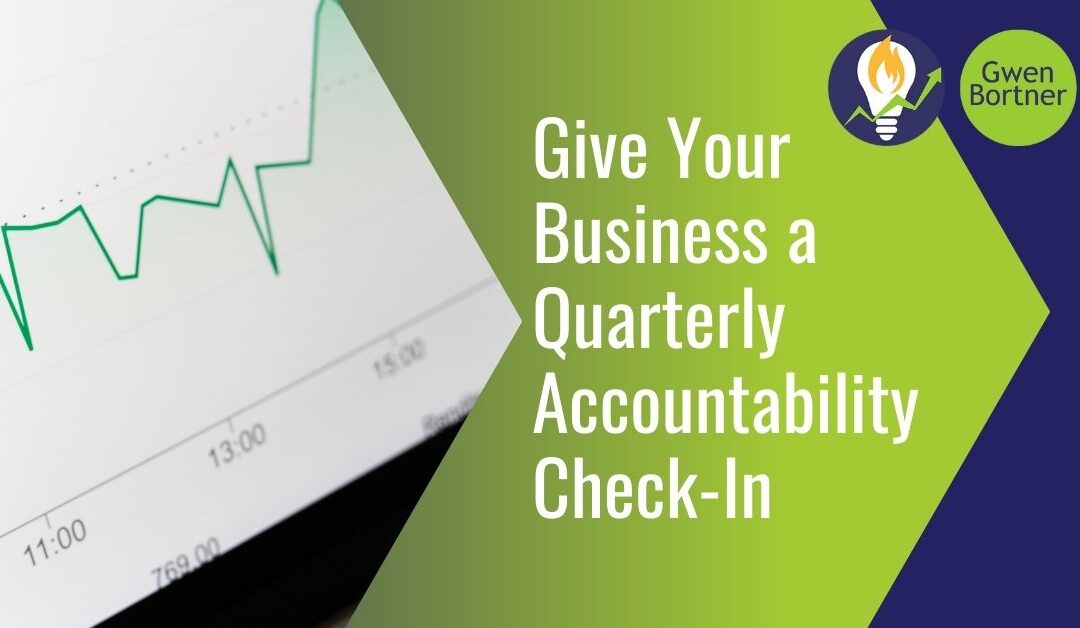
by Gwen Bortner | Leadership, Operations
Do you ever finish out your work day and wonder where the time went? Do you feel like you’re not really accomplishing very much, even though you’re working all day? Chances are you’re losing crucial time in your business trying to do too many different tasks, or manage too many different people. A solution for this problem is to create an accountability chart for your business.
An accountability chart is like an organizational chart, but with one key difference: an accountability chart focuses on what people are going to be accountable for rather than just listing their job description. I would love to take credit for this idea, but the first time I was exposed to it was in the book Traction by Gino Wickman.
Creating an accountability chart will help you get clarity on who’s doing what, but also help you step back and take accountability only for the tasks you’re supposed to be handling as the CEO. For everything else, your only job is to hold your people accountable for what they owe you.
How to Create an Accountability Chart in Your Business
Step 1: List the tasks that must be completed in order to run your business.
You can group these into different areas, but don’t let yourself get boxed into existing job descriptions or the people who are currently working for you. Think only about the actual tasks that need to go on somebody’s To Do list in order for your business to keep running every day. List them all.
Step 2: Group those tasks into roles.
Think about the most logical way to combine those tasks into roles, or job descriptions. No matter how you’ve done it in the past, this is a chance to invent the best practices that will carry your business forward. If someone is doing Task A, which other tasks are the most logical for them to take on as part of their role in your company?
Step 3: Define the accountability for each role.
What is the deliverable outcome for each job description? What will that person need to be accountable for producing as they complete those tasks? You may also want to use this step to put a time frame on this accountability: how frequently do these tasks need to be completed for maximum results? Is there any flexibility on this, depending on the person you eventually hire to fill this role?
Step 4: Determine the number of hours or people needed to fill this role.
It’s only natural that the roles you have in your business will grow as your business does, but think about right now: how many hours per day or week would it take someone to fulfill the duties of each role? Chances are, when you’re just starting out, one person (maybe even you) can take on several roles at once. It’s still important to define them as separate roles, though, so that as the business grows that person can pass off some roles to other people and fill more of their time doing fewer jobs.
Step 5: What is the appropriate accountability structure?
This is where the accountability chart starts to look more like an organizational chart. A Chief Financial Officer role may also be accountable for ensuring the roles of Bookkeeping and Payroll Tax Preparation are being fulfilled. And right now, those roles all may be the same person. However, as your business grows, those roles may be taken over by other people. Keep in mind, we are designing for the future, not just the present.
Step 6: Share as needed.
Everyone who works for you doesn’t need a detailed job description for every other person in the business, but they do need at least a baseline of information. If I’m your employee, I need to know my own job in pretty strong detail so that I make sure to complete my tasks and maintain the things I’m accountable for. I also need to know who I report to with questions, problems, and results. For everyone else in the business, I just need to have a basic idea of their role so that if an item comes across my desk that should really be theirs, I know where to forward it.
As you develop your chart, remember that accountability is key. You don’t want “too many cooks in the kitchen,” or too many folks who are accountable for the same thing. The higher up you go on your chart, the fewer people should be accountable for each outcome. Fundamentally each role should be able to be summarized by 3 – 5 bullet points.
It may seem unnecessary if you’re still at the stage of business where you’re doing most of the work, or you only have 1 or 2 employees or contractors. However, having clear roles now means it’s easier to grow your business down the road, because you can hire people according to their strengths. If one person is balancing multiple roles right now, they can eventually give away the ones that aren’t firmly in their wheelhouse in order to focus on the ones that are.
If you need some help identifying the roles in your business and holding your team accountable for their tasks, come join us in the Operations Engine. You’ll get support from other CEOs like yourself, with guidance and advice from me every step of the way. Click here to schedule a call for more information.
(PS: if you’d like to dig deeper into this topic, I really recommend the book Traction: Get a Grip on Your Business, by Gino Wickman. It has some really practical advice for how to get a handle on your business operations.)

by Gwen Bortner | Operations
Most successful business owners have mastered the art of being accountable to others. You deliver on time to your clients, you write regular checks to your team, you never miss an appointment with your mentor or mastermind group. When it comes to being accountable to yourself, are you just as reliable? Or do you let yourself fall short because no one else is on the receiving end of your accountability?
If you want your business to thrive or grow, you need to be just as accountable to yourself as you are to everyone else. Part of this means that every quarter, you set aside the time to do a check-in on your business. You need to know exactly where you stand right now, and also be able to compare your current situation to past performance in order to set goals for the future.
Right now, schedule some time on your calendar to do an accountability check-in with your business this month.
Here’s what you should be checking for:
- Numbers: Look at your key performance indicators, metrics, and financial reports from the past quarter.
- Team: Evaluate the performance of each of your team members over the past quarter.
- Vision: What are your goals for the rest of this year? How about longer than that? How close are you to achieving those goals, based on the information you’ve found today?
For each of the key areas, make a place to document your current status. A spreadsheet or document where you can keep records for each check-in together would be the best option.
As you document your check-in, make sure to record the following information:
- Where am I right now for this indicator? What is the actual performance in this area for the past quarter? (This should be something measurable – dollars, percentages, number of clients, etc.)
- How does this compare with last quarter? How does it compare to this quarter of the previous year? (If you haven’t done a check-in like this before, you may have to save this question for next quarter.)
- How does this compare with where I would like to be at this point in my business? (This is a time to celebrate any successes and reevaluate anything that isn’t working.)
- Are there any outside factors I need to note? (This might include things like natural disasters, a global pandemic, a personal health issue, a loss of a team member, etc.)
At the end of your check-in, take some time to adjust your goals if need be, and then schedule your next check-in for the following quarter right away. Prioritizing this type of assessment is key to the life and success of your business, so you have to find a way to hold yourself accountable for it, no matter how busy life gets.
If you need some help on that accountability piece, I’d love to offer you that. Book a session with me and I will help you break down your current numbers, set manageable goals, and – most importantly – hold you accountable for taking the action required to meet those goals, and to establish a regular habit of checking in on your business.

by Gwen Bortner | Leadership
When you first started your business, you were probably the only person working in that business. You had to learn to be the “Jack of All Trades” in order to get your business off the ground and keep it running. This is a solid way to start a business, but at a certain point if you haven’t transitioned out of this situation, your business isn’t going to grow.
It’s time to start thinking of yourself as the CEO of your business, and acting accordingly.
Get Clear on Your Vision
As the CEO of your business, you need a clear vision: a mission statement that details what your business does, who it serves, and where it’s going. If you don’t have a vision, then you’re just treading water, and you aren’t going to gain any momentum.
If it has been a while since you thought about your vision for your business, it may be time to revisit that. Think about what you really want from your business, and actually write down your big-picture vision. Post it somewhere that you will see it often, but also make sure to share it with your team.
Identify the Roles in Your Business
As part of your vision, think about how many roles your business needs to have in order to function properly and keep moving toward your goals. (It’s important to note that a role isn’t the same as a person; for some roles, you may have several people doing them, and for others you may have one person covering several roles.)
If you have been carrying too many of those roles yourself, it’s time to delegate them to someone else. Get clear about what you want out of your role as the CEO, and put everything else on someone else’s To Do list. As the CEO, you should primarily be your business’s leader, its overseer, and its driving force. You should not be your business’s “muscle,” doing every single task that comes through.
Now is also a good time to evaluate whether you have the right people fulfilling the right roles in your business. If not, it may be time to hire some new folks or let others go.
Communicate with Your Team
Once you have a clear vision and a solid idea of the roles that need to be filled, it’s time to make sure that everyone else on your team understands those things as well. You don’t have to have actual employees for this, though one day that should probably be your goal. For now, if you have independent contractors working for you, make sure they understand the vision you have for your company and their role in bringing that vision to life.
Here are some examples:
- Your accountant probably doesn’t need a deep understanding of your full vision, but they do need to know your financial goals so that they can make recommendations to help you reach them.
- Your assistant needs to have a firm grasp on the vision for your company so that they can help you stay true to that vision in the day-to-day tasks of the business.
- If you have more than one person in an assistant-like role, each one needs to understand the breakdown of tasks they are responsible for and who they report to on a daily basis.
- Your ghost writer or content creator needs a clear idea of the big picture so that they can communicate that with every new piece they create for you.
- Your webmaster needs to understand your goals so that they can make sure that your website is optimized to help you reach those goals.
As you look at your business with an objective lens, are you really doing the work of a CEO, or are you still playing around in “Jack of All Trades” territory? If you need some help getting clear on your vision, your team, and the roles your business probably needs to have, click the link below to book a call with me. Sometimes an outside perspective is all you need to get clear and then start taking action to align your business’s reality with your vision for it.
CLICK HERE TO CHAT WITH ME




